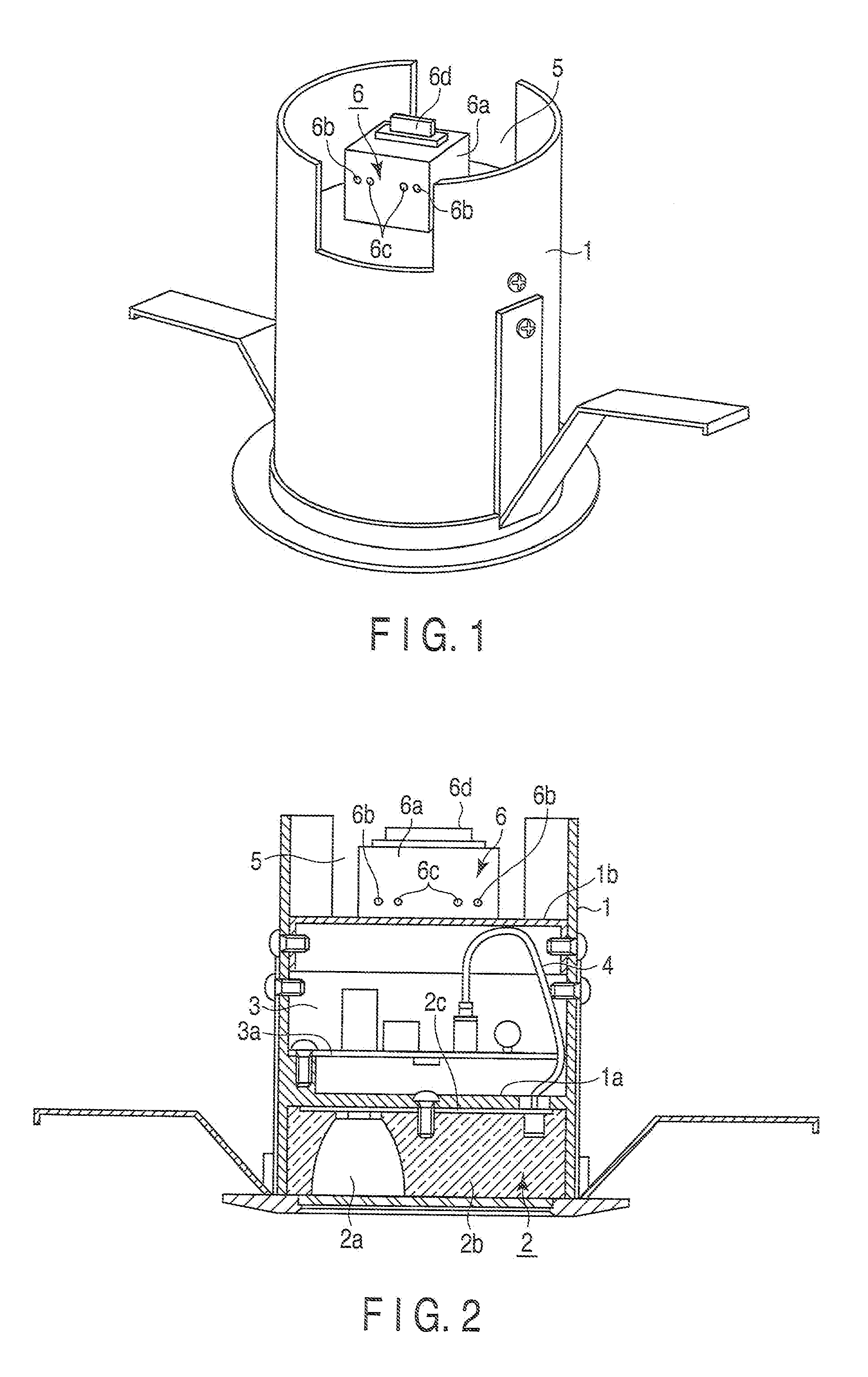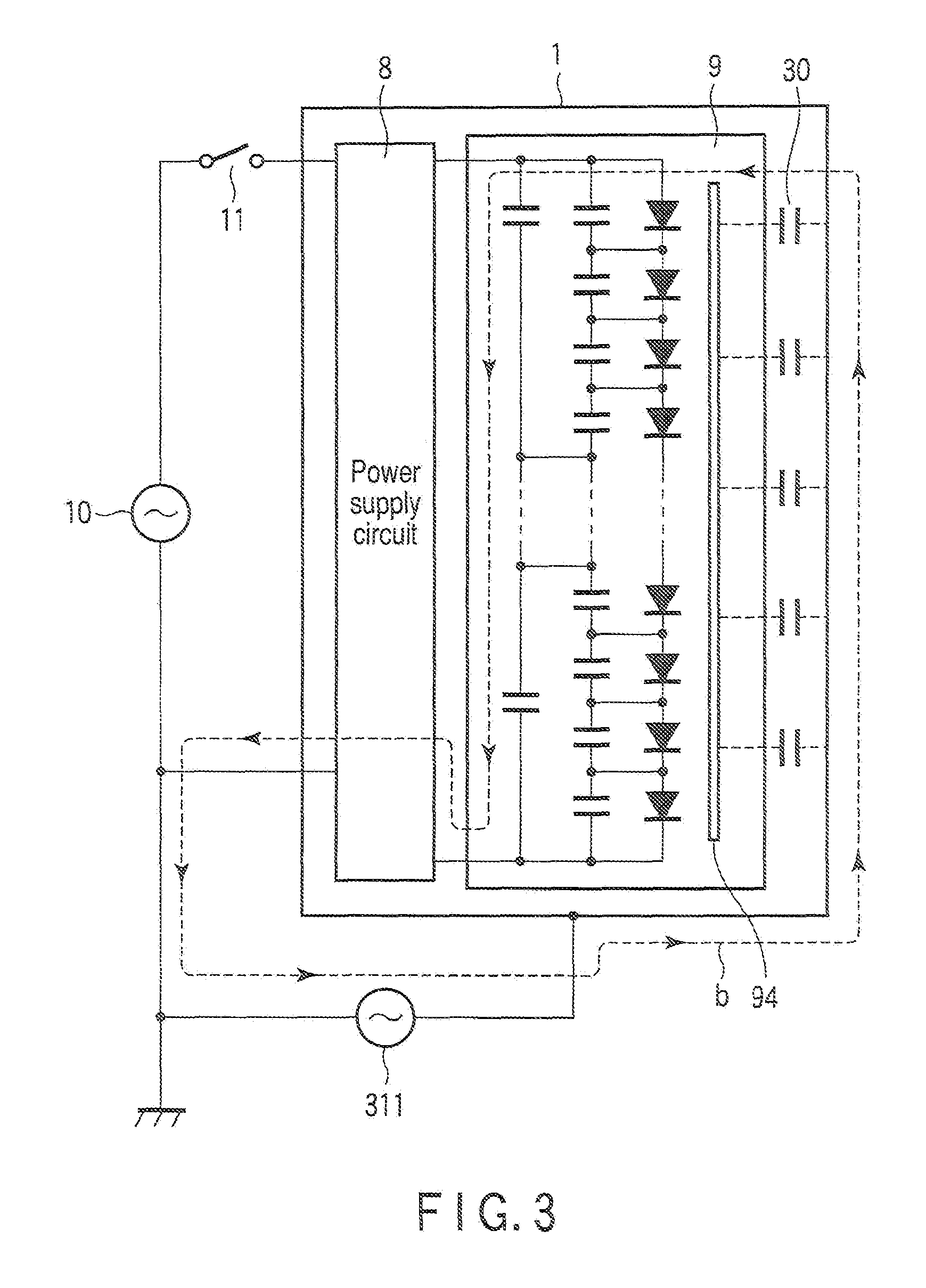Light-emitting device and illumination apparatus
a technology of light-emitting devices and illumination apparatuses, which is applied in lighting apparatuses, electroluminescent light sources, light sources, etc., can solve the problems of /b> connected to a higher potential side being erroneously turned, increasing both the size and cost of the apparatus, and achieving the effect of positive removal of the effect of external nois
- Summary
- Abstract
- Description
- Claims
- Application Information
AI Technical Summary
Benefits of technology
Problems solved by technology
Method used
Image
Examples
first embodiment
[0043]First, an illumination apparatus according to the present invention is briefly explained. In FIGS. 1 and 2, a housing 1 of the apparatus proper is formed of die-cast aluminum and in the shape of a cylinder open at both ends thereof. The interior of the housing 1 is divided vertically into three parts by partitioning members 1a and 1b, and the space between the lower opening and the partitioning member 1a is formed in a light source unit 2. The light source unit 2 includes a plurality of LEDs 2a as semiconductor light-emitting elements and a reflector 2b. The plurality of the LEDs 2a are arranged and mounted equidistantly along the circumference of a discal wiring board 2c arranged on the lower surface of the partitioning member 1a.
[0044]The space between the partitioning members 1a and 1b of the housing 1 is formed in a power chamber 3. The wiring board 3a is arranged above the partitioning member 1a of the power chamber 3. Electronic parts making up a power circuit to drive ...
first modification
[0064]FIG. 6 shows an LED module according to a modification of the first embodiment described above. In this modification, the LED module 31 is configured of a plurality of (six, in the shown case) LED elements 311a to 311f connected in series, and this series circuit is connected between a positive line 31a and a negative line 31b of the DC power output. The LED elements 311a to 311f are connected in parallel to first bypass capacitors 312a to 312f, respectively. Further, the series circuit of the LED elements 311b to 311f is connected in parallel to a second bypass capacitor 313a, the series circuit of the LED elements 311c to 311f is connected in parallel to a second bypass capacitor 313b and the series circuit of the LED elements 311e and 311f is connected in parallel to a second bypass capacitor 313c. These second bypass capacitors 313a, 313b and 313c have the negative line 31b as a grounding point A1, and with this grounding point A1 as a reference, the AC impedance against t...
second modification
[0066]FIG. 7 shows an LED module according to another modification of the first embodiment.
[0067]In this modification, as shown in FIG. 7, the LED module 32 is configured of a plurality of (six, in the shown case) LED elements 321a to 321f connected in series, and this series circuit is connected between a positive line 32a and a negative line 32b of the DC power output. The LED elements 321a to 321f are connected in parallel to first bypass capacitors 322a to 322f, respectively. Further, the series circuit of the LED elements 321b to 321e is connected in parallel to a second bypass capacitor 323a, and the series circuit of the LED elements 321d and 321e is connected in parallel to a second bypass capacitor 323b. These second bypass capacitors 323a and 323b have the negative line 32b of the LED elements 321a to 321f as a grounding point A2, and with this grounding point A2 as a reference, the AC impedance against the ground at connection points B2, C2, D2 and E2 of the series circui...
PUM
 Login to View More
Login to View More Abstract
Description
Claims
Application Information
 Login to View More
Login to View More - R&D
- Intellectual Property
- Life Sciences
- Materials
- Tech Scout
- Unparalleled Data Quality
- Higher Quality Content
- 60% Fewer Hallucinations
Browse by: Latest US Patents, China's latest patents, Technical Efficacy Thesaurus, Application Domain, Technology Topic, Popular Technical Reports.
© 2025 PatSnap. All rights reserved.Legal|Privacy policy|Modern Slavery Act Transparency Statement|Sitemap|About US| Contact US: help@patsnap.com



